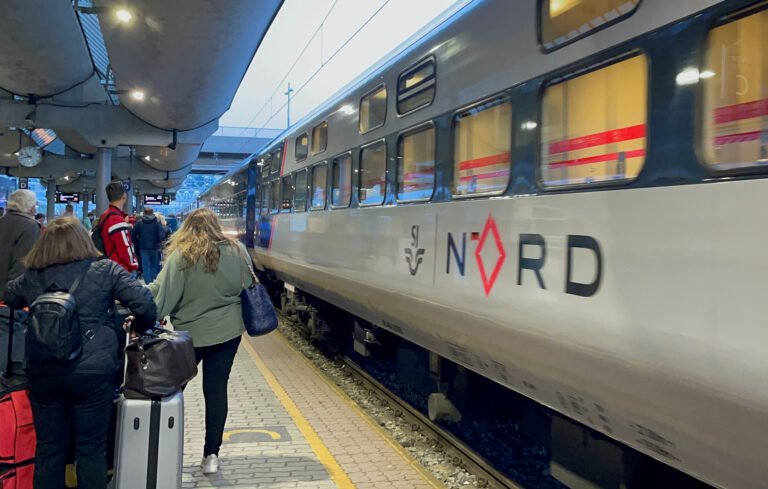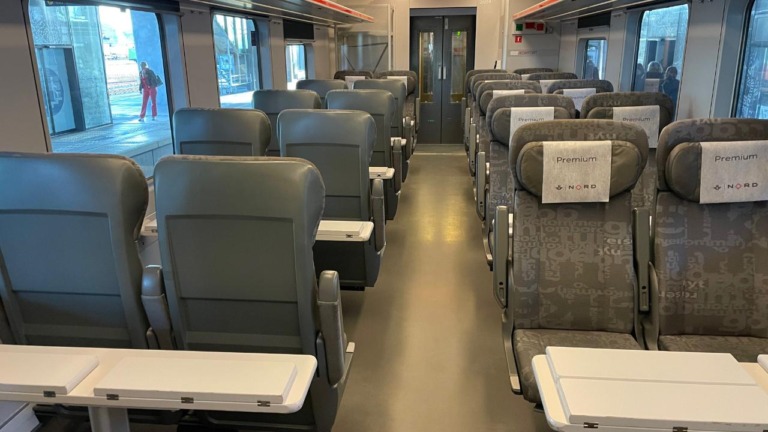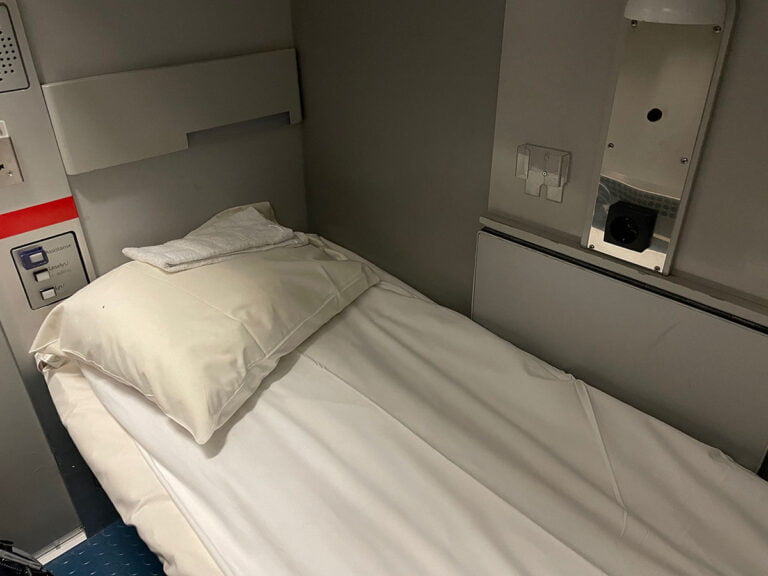Norway's Dovrebanen railway is a historic transport route that links two of Norway's biggest cities, Oslo and Trondheim. For tourists, it's a scenic option to consider for your travel itineraries.
Not long after I first moved to Norway back in 2011, I began to travel to Trondheim quite a bit. I chose the train. It was the cheapest option, and before I'd fully adjusted to the cost of living in Norway, that was all that mattered.

After I moved there in 2013, I often returned to Oslo by train. These days I still travel between Oslo and Trondheim by train a lot, especially if I'm not in a rush.
The train glides over the mountains of Central and Eastern Norway allowing me to enjoy a coffee, get some work done, or relax and read a book.
The Dovre line is now one of several rail lines in Norway operated by SJ Nord. As of late May 2024, the route (known as F6 on timetables) is known reopen following the long-term maintenance work needed following Storm Hans damage,
If you're considering the trip, read on for everything you need to know.
Delight in the Dovre journey
It's always easy to spot tourists. While not as famous nor as stunning as the Bergen line, Dovrebanen (the Dovre line) still offers travellers plenty of scenic enjoyment.
Four daily departures enable voyagers to embrace the 6.5 to 7-hour scenic journey, presenting a serene alternative to air travel. For those who prefer travelling under the starry skies, a 7.5-hour night train operates most evenings.

Conveniently, every train stops at Oslo Airport, making it an option for inbound and outbound air travellers, although this very much depends on departure times.
From Oslo to Trondheim over the mountains
Merely an hour into the journey from Oslo, the serene expanse of Lake Mjøsa, Norway's largest freshwater lake, unfolds. To enjoy the scenery, travellers should secure a seat on the left if heading north, and on the right when journeying south.
The train's trajectory then traces past Lillehammer, famously recognized as the Winter Olympics' 1994 venue.
The real magic unfolds as the train begins its ascent through the heart of Norway's mountains, making a brief stop at Dombås. This stopover isn't just about stretching legs but also offers a connection to the scenic Rauma line, leading towards Åndalsnes.
Journeying onward, the iconic Dovrefjell mountain pass unveils itself. Historically significant, this pass once served as a critical transit route. Today, it’s a sanctuary for wild reindeer and the intriguing musk oxen, a species introduced from Greenland in the 20th century.

Among the range, the towering Snøhetta stands tall. Although it once mistakenly held the title of Norway's loftiest peak, its majesty remains undeniable.
When weather permits, and especially on the rare occasion that the elusive musk oxen grace with their presence, the conductor often shares these exhilarating moments with passengers. So, listen up!
Upon arrival in Trondheim, a world of historic and natural wonders await. The majestic Nidaros Cathedral adorned with sculptures, the quaint old town district of Bakklandet, and the wild expanse of the city forest, Bymarka.
The SJ experience
Since 2020, the Oslo-Trondheim train has been operated by SJ Nord, an arm of the Swedish SJ. They also operate the Nordland line to Bodø, the Røros line, and the Rauma line.
Tickets are sold not through SJ, but through En Tur. Translated as ‘One Trip', the service is designed to be a one-stop shop for most train and long-distance bus travel in Norway.

Generally, you can buy a fixed ticket or a flexible/refundable ticket, with the latter coming at an extra cost. On the Oslo-Trondheim line, there are also several classes of travel.
Classes of travel
A regular seat on the train is perfectly comfortable. The carriages are setup in a 2×2 seating formation, with some seats facing backwards, and some seats arranged in a group of four around a table.
You can clearly see your options for selecting a seat when you book a ticket online. One coach of regular seating is usually designated for families. I strongly advise to avoid these coach if you're not travelling with children!
The Premium cabin offers a slight improvement in comfort, but the only significant benefit is free hot drinks throughout the journey. If you travel before 9am, you'll also be served a simple breakfast at your seat.
In 2022, a new ‘Premium Plus' coach was introduced. These plush 2×1 airline-style seats have a much greater recline and feature inclusive food served at the seat. Premium Plus coaches are available on some departures, including the night trains.
Dining car
The SJ dining car is available on all departures, offering snacks, hot and cold drinks (including beer), and hot meals. The ‘hearty ‘Dovre burger' and traditional Norwegian waffles are among the best sellers.

Food can be pre-ordered, but most people just wander into the dining car whenever they're feeling hungry. There is limited canteen-style seating in the dining car, but you can also take your food and drink back to your seat if you prefer.
Night trains on the Dovre Line
For nocturnal adventurers, night trains are available six times a week. They run each night in both directions, with the exception of Saturday night.
You can book a regular seat but I've never been able to sleep particularly well given the movement of the train and the frequent stops. On the plus side, it's by far the cheapest option.
The Premium Plus cabin is available on night trains. If you're the kind of person who can sleep on a plane, that could be a good option for you.
Sleeping cabins accommodating two adults in bunk beds are available. Although very compact, they do offer the opportunity to lie down! I tend to sleep okay, sometimes well, in the sleeping cabin.

The big disadvantage with the sleeping cabins is their popularity. They tend to sell out well in advance.
If you can secure a sleeping cabin, they can potentially save you money on a hotel when planning your travel itinerary. However, bear in mind that the night trains aren't especially long in duration.
For example, the Oslo to Trondheim night train typically departs at 10.50pm and arrives at 6.24am. From Trondheim, the night train typically departs at 11.17pm and arrives at 6.50am. So even if you do get some sleep, you'll have a very early start.
Have you taken the Oslo to Trondheim train? What were your experiences? Let us know in the comments below.


I’ve travelled this route many times on my visits to Norway and always enjoyed it. Glad to hear that the bridge at Ringebu is now replaced and through trains restarted.
The mountain section over Dovre is not as dramatic or as high as the Bergen route, but then neither does the train keep disappearing into one tunnel or snow shed after another!
Dombås is a good stopover, with lots of good hiking (or cross-country skiing in winter) and several national parks within close reach. The Rauma railway down to the ski resort at Bjorli and the fjords at Åndalsnes is definitely worth doing – just a shame the first train down isn’t until midday, to connect with the first trains from Oslo and Trondheim.
Hjerkinn and Kongsvold up on the Dovre plateau are good starting points for longer distance hikes – the former has a short walk to the spectacular Snøhetta pavillion/outlook. A walking trail connects both stations.
Oppdal station a little further north seems to be a popular stop among Norwegians for skiing.
And Trondheim is becoming my favourite city in Norway, if only because the sun always seems to shine when I’m passing through!